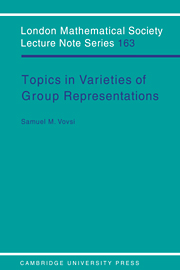Chapter 3 - IDENTITIES OF FINITE AND STABLE-BY-FINITE REPRESENTATIONS
Published online by Cambridge University Press: 06 January 2010
Summary
The problem of determining which varieties are finitely based is one of the major problems of the theory of varieties of arbitrary algebraic structures. The theory of varieties of group representations is no exception, and at all stages of its development the problems associated with the existence of a finite basis of identities have remained at the center of attention. It should be emphasized, however, that the existence of non-finitely-based varieties of group representations is an immediate consequence of the existence of nonfinitely-based varieties of abstract groups, established in 1970 by Ol'shansky [70], Adjan [1] and Vaughan-Lee [88]. Therefore the essence of the finite basis problem for varieties of group representations is the search for various interesting and natural cases in which the problem has a positive solution.
The considerations of the present chapter were inspired by the remarkable theorem of Oates and Powell [69] asserting that every finite group has a finite basis of identities. Our initial question is the following: does every representation of a finite group over a field have a finite basis of identities? The first step in this direction has been done in [91, 92]: it was proved that for ordinary representations the answer is positive. This rather simple fact was substantially generalized by Plotkin [78] who proved that there is a finite basis of identities for every special representation, that is, a representation ρ = (V, G) such that (i) V is finite-dimensional, (ii) G has a normal subgroup of finite index acting stably on V, and (iii) |G/H| is not divisible by the characteristic of the ground field.
- Type
- Chapter
- Information
- Topics in Varieties of Group Representations , pp. 113 - 145Publisher: Cambridge University PressPrint publication year: 1991



